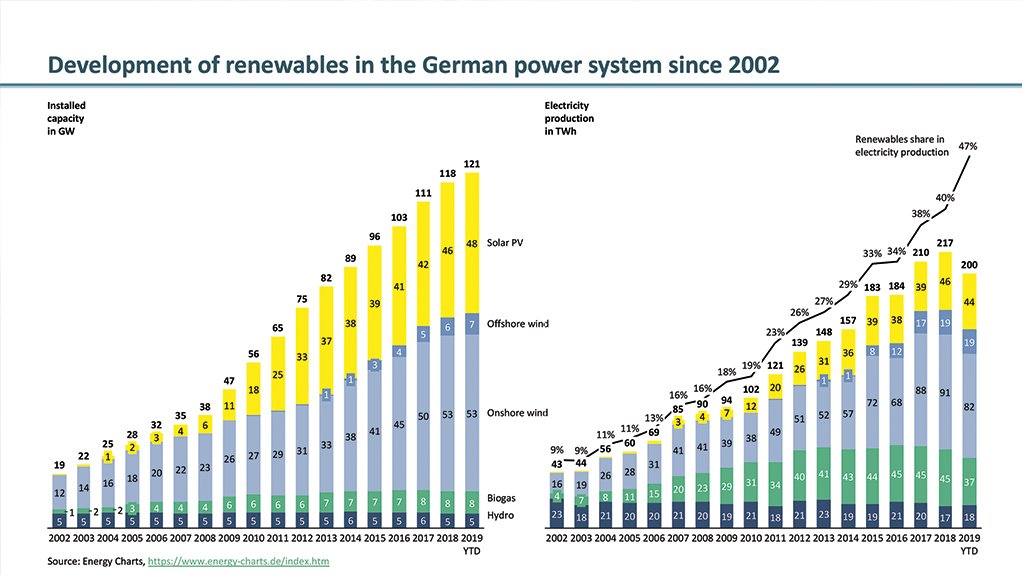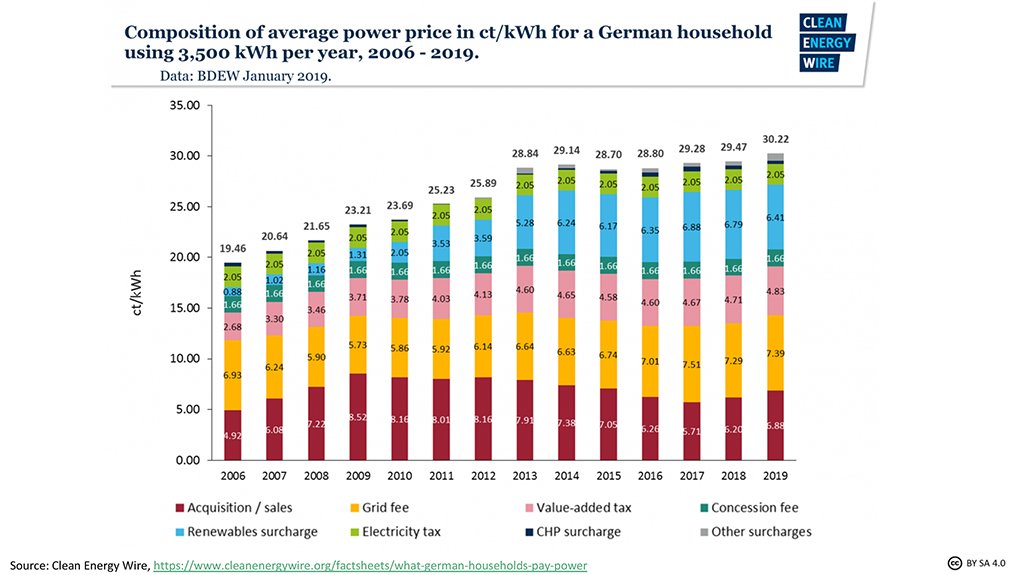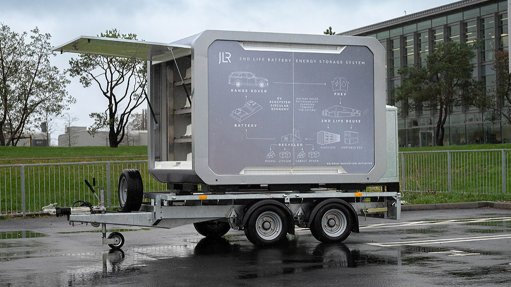Opinion: Why do German households pay high electricity prices if renewables are cheap?
Germany’s electricity generation in 2019 year-to-date has been almost 47% based on renewables, a significant increase from only 9% in 2002. The cost of new renewables, specifically solar photovoltaic (PV) and onshore wind, are now by far the lowest of all new-build power-generator options. Why then are German household electricity prices some of the highest in the world? The average German residential household pays 30.22 euro cents (€ct) for a kilowatt-hour (kWh) of electricity, which is about R4.80/kWh.
The answer is twofold. First, Germany started to invest into renewables at a time when the technologies were still expensive. Because the assets are financed on the back of 20-year offtake agreements, whose annual payment obligations are charged as a renewables levy on the electricity end-consumers, these high costs will be felt in the power system until the early 2030s. Second, household electricity prices are generally not a very good proxy for the cost of electricity generation, because they include a number of cost items that are not related to the generation source of electricity and are additionally levied with consumption taxes and levies that are not related to energy at all. In Germany, that is particularly true.
Unpacking the early-renewables theme further, it becomes apparent that there are three reasons for the high costs.
Firstly, Germany built 33 GW of solar PV before 2013. Projects built in 2012 received tariffs of between 20 and 30 €ct/kWh, or R3 to R5/kWh, while projects built as early as 2004 received tariffs as high as 45 to 56 €ct/kWh (R7 to R9/kWh). Owing to the 20-year offtake agreements, these very high costs of early solar PV still have to be paid by the electricity consumers until the early 2030s. New solar PV in the latest German auctions is now procured at below 5 €ct/kWh, at a solar resource that is roughly 50% lower than that of South Africa’s resource.
Germany furthermore built 6 GW of biogas-fired power generators before 2013. Those run in low-value baseload operation and, hence, produce more than 40 Terawatt-hours (TWh) of electricity a year. This electricity is compensated with a tariff of 15-20 €ct/kWh (R2.50 to R3.00/kWh). This again applies until the early 2030s.
Thirdly, Germany started to build offshore wind projects about four years ago at tariffs of more than 15 €ct/kWh for the early projects.
The nonrenewables-related reasons, meanwhile, can be explained as follows:
The high cost of early renewables outlined above is borne only by households and small businesses. Electricity-intensive industry in Germany is exempt from the levy to pay for the renewables’ costs. That is good for the electricity-intensive industry. It distorts the picture, though, as households carry a higher- than-pro-rata burden of the early renewables costs.
In the 1980s, Germany decided to generally put all low- and medium-voltage overhead lines underground. That increases the reliability of the power system at the distribution and reticulation levels, but it also increases costs quite significantly. One can see that reflected in the level of the German grid charges (the regulated part of the power system), which are very high compared with other countries with more overhead lines and fewer underground cables. The regulated grid charges alone stand at 7.39 €ct/kWh (R1.20/kWh) for residential household electricity customers. To be clear, renewables are not the reason for the high grid charges in Germany. That is borne out by the fact that the grid charges have not increased since the large-scale introduction of renewables. In fact, on an inflation-adjusted basis, these charger have decreased since 2006, when they stood at 6.93 €ct/kWh (R1.10/kWh) in nominal terms.
Then there are also three nonenergy-cost-related reasons for the high prices.
Firstly, Germany generally burdens final energy use at the ultimate end-consumer with extra levies in order to promote energy efficiency. Electricity use is burdened with 2.05 €ct/kWh (0.33 R/kWh) for an ‘electricity tax’, the proceeds of which flow into the public retirement scheme.
There is furthermore a 1.66 €ct/kWh (0.27 R/kWh) concession fee, payable to municipalities. This fee is not cost related, but is simply an unconditional revenue stream for municipalities (not much different to the part of the surplus that municipalities in South Africa make on electricity sales and use for nonelectricity-related cost items.
Of course, value-added tax needs to be removed from the picture when comparing fundamental cost drivers across different countries. That is 19%, or 4.83 €ct/kWh (0.77 R/kWh) in Germany.
These three nonenergy-cost-related components alone already explain 8.54 €ct/kWh (R1.37/kWh) or almost 30% of the entire German household electricity price. Overall, 16 to 17 €ct/kWh (R2.60 to 2.70/kWh) of the total 30 €ct/kWh (R4.8/kWh) that German households pay for electricity are either not energy related at all, or are energy related (grid costs), but not renewables-related.
The renewables-related component is high mostly because of the procurement of large amounts of very expensive solar PV and biogas at an early stage, and more recently because of the first offshore wind farms.
The long-term offtake agreements used to finance these assets mean that this cost burden will not decrease any time soon. But with mathematical precision it will vanish in the early 2030s, when none of the early solar PV plants will receive their high tariffs anymore, but will keep producing electricity at very low operational cost of a written-off, originally capital-intensive asset.
New onshore wind and new solar PV are by far the cheapest new-build options in the German power mix today. That is becoming true for new offshore wind too.
In summary, the level of German household electricity prices cannot be used to measure the cost of transitioning a power system from conventional sources (coal, gas, nuclear) to a renewables-led power system, because they contain many nonrenewables-related cost items and because the high initial costs of renewables are no longer relevant today.
Comments
Press Office
Announcements
What's On
Subscribe to improve your user experience...
Option 1 (equivalent of R125 a month):
Receive a weekly copy of Creamer Media's Engineering News & Mining Weekly magazine
(print copy for those in South Africa and e-magazine for those outside of South Africa)
Receive daily email newsletters
Access to full search results
Access archive of magazine back copies
Access to Projects in Progress
Access to ONE Research Report of your choice in PDF format
Option 2 (equivalent of R375 a month):
All benefits from Option 1
PLUS
Access to Creamer Media's Research Channel Africa for ALL Research Reports, in PDF format, on various industrial and mining sectors
including Electricity; Water; Energy Transition; Hydrogen; Roads, Rail and Ports; Coal; Gold; Platinum; Battery Metals; etc.
Already a subscriber?
Forgotten your password?
Receive weekly copy of Creamer Media's Engineering News & Mining Weekly magazine (print copy for those in South Africa and e-magazine for those outside of South Africa)
➕
Recieve daily email newsletters
➕
Access to full search results
➕
Access archive of magazine back copies
➕
Access to Projects in Progress
➕
Access to ONE Research Report of your choice in PDF format
RESEARCH CHANNEL AFRICA
R4500 (equivalent of R375 a month)
SUBSCRIBEAll benefits from Option 1
➕
Access to Creamer Media's Research Channel Africa for ALL Research Reports on various industrial and mining sectors, in PDF format, including on:
Electricity
➕
Water
➕
Energy Transition
➕
Hydrogen
➕
Roads, Rail and Ports
➕
Coal
➕
Gold
➕
Platinum
➕
Battery Metals
➕
etc.
Receive all benefits from Option 1 or Option 2 delivered to numerous people at your company
➕
Multiple User names and Passwords for simultaneous log-ins
➕
Intranet integration access to all in your organisation























